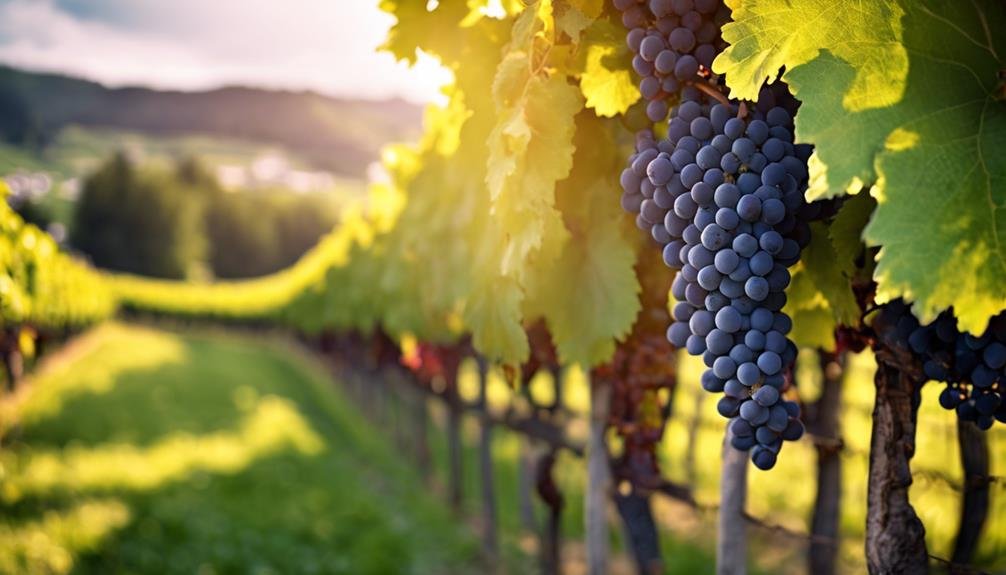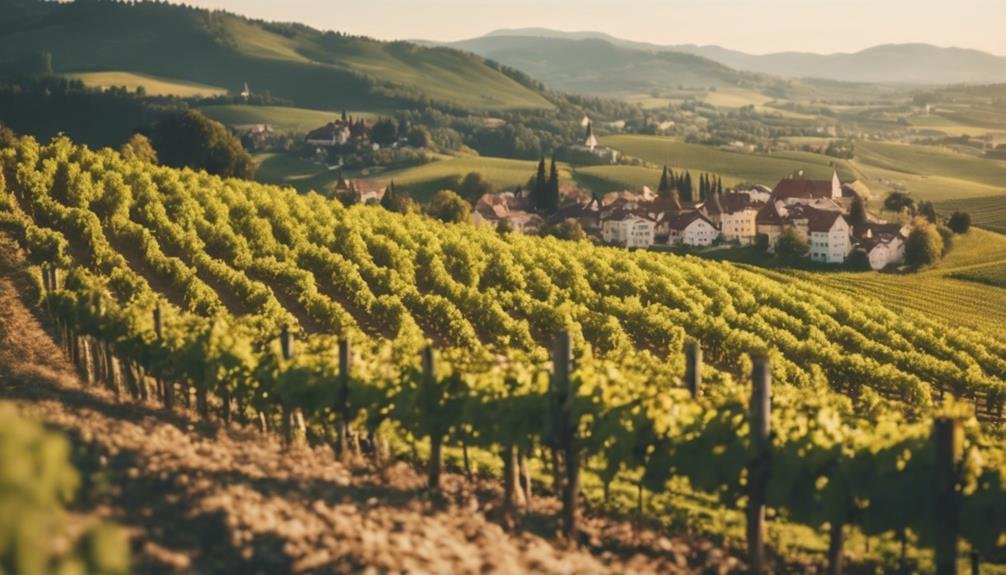Experience Austria's diverse wine wonderland with its scenic vineyards, renowned for dry whites and fruity reds shaped by a cool continental climate. Grapes thrive in picturesque landscapes, offering distinct flavors marked by higher acidity and lower alcohol. Discover Grüner Veltliner, a standout white with high acidity and oak-aged quality akin to Chardonnay. Explore Zweigelt, a popular red grape known for its tart fruit flavors and ideal pairings with light meats. Engage with Austria's sparkling wine, Sekt, in various styles from Klassik to Reserve tiers, complementing seafood and salads. Uncover the enchanting world of Austrian wines with unique flavors and traditions.
Austrian Wine Regions Overview
When exploring Austrian wine regions, it becomes evident that the majority of vineyards are located in the eastern part of the country, known for its cooler continental climate that yields dry whites and fruity reds. The vineyard landscapes in eastern Austria offer picturesque views with rolling hills and meticulously maintained rows of grapevines.
Climate variations play an essential role in shaping the flavors of Austrian wines, with cooler temperatures allowing for the production of lighter, more acidic wines with pure fruit expressions. These climate conditions also contribute to higher acidity levels and lower alcohol content in the wines, creating a distinctive profile that sets Austrian wines apart.
Understanding these climate influences can enhance one's appreciation of the diverse range of wines that Austria has to offer.
Cool Climate Influence on Wines
The impact of cool climate conditions on wine production is a defining factor in shaping the unique characteristics of Austrian wines. Cool climate wines from Austria are known for their higher acidity levels, which contribute to their crispness and invigorating qualities. Varietals grown in these cooler regions display more delicate fruit flavors and elegant profiles due to the slower ripening process under colder conditions.
These wines often have lower alcohol content, allowing the natural acidity to shine through. The cool climate also helps in retaining the acidity in grapes, resulting in wines that are vibrant and well-balanced. Austrian winemakers have mastered the art of producing acidic varietals in these conditions, creating wines that are highly sought after for their distinctive and invigorating qualities.
Spotlight on Grüner Veltliner

Cool climate conditions in Austria have set the stage for Grüner Veltliner to shine as the country's most significant and esteemed white wine variety. This light-bodied wine is characterized by high acidity, making it a favorite among wine enthusiasts.
Grüner Veltliner holds cult status in Lower Austria and is known for its budget-friendly options, offering peppery acidity and green melon flavors. Surprisingly, when aged in oak barrels, Grüner Veltliner reaches higher quality levels comparable to Chardonnay.
This versatile wine is a perfect choice for those seeking a unique white wine experience that won't break the bank. Whether enjoying it on its own or pairing it with a variety of dishes, Grüner Veltliner remains a top choice for wine lovers looking for quality and affordability.
Exploring Zweigelt and More
Let's delve into the exploration of Zweigelt and other notable Austrian wine varieties.
Zweigelt, a light-bodied red wine, is the second most planted grape in Austria. It offers tart red fruit flavors, higher acidity, and lower tannins, making it ideal for dry rosé and red wines. This versatile grape pairs excellently with lighter meats and fish, enhancing the dining experience. When considering aging potential, Zweigelt is typically best consumed within a few years of production to enjoy its vibrant fruitiness.
Additionally, Blaufränkisch and Saint Laurent, both gaining popularity in Austria and Germany, offer medium-bodied options with distinctive flavors suitable for various food pairings. Understanding the characteristics of these Austrian wines can enrich your wine-tasting journey.
Sekt: Austrias Sparkling Wine

Exploring the world of Austrian wine beyond Zweigelt and other notable varieties, Sekt stands out as Austria's renowned sparkling wine offering, characterized by distinct quality restrictions and tiered production methods introduced in recent years.
Sekt trends show an increasing demand for this invigorating delight, with a rise in production and consumption. The production of Sekt involves a meticulous process, with the Klassik style being the basic version, while the Reserve and Große Reserve tiers require specific methods, resulting in richer and more complex flavors.
When tasting Sekt, expect vibrant bubbles with crisp acidity and notes of green apple and citrus. This versatile sparkling wine pairs excellently with a variety of foods, including seafood, light salads, and creamy cheeses, enhancing the dining experience with its revitalizing character.
Frequently Asked Questions
What Are the Unique Soil Types Found in Austrian Wine Regions?
Microclimate influences in Austrian wine regions contribute to diverse soil types. Organic viticulture enhances terroir impact, reflecting in grape varietals like Grüner Veltliner and Zweigelt. Soils range from loess, slate, and limestone, influencing wine complexity and character.
How Do Austrian Winemakers Combat Frost in Their Vineyards?
Austrian winemakers combat frost in vineyards by utilizing frost protection methods such as vineyard heaters and wind machines. Additionally, they employ cover crops to help insulate the soil and vines during cold spells, safeguarding the grape harvest.
Are There Any Famous Wine Festivals or Events in Austria?
Austria hosts renowned wine festivals like the Vienna Wine Spring, showcasing diverse wines and cultural events. Wineries emphasize vineyard sustainability and organic practices, making wine tourism a vibrant experience. Visitors can enjoy a blend of tradition and innovation.
What Is the History Behind the Resurgence of Blaufränkisch and Saint Laurent Grapes?
The resurgence of Blaufränkisch and Saint Laurent grapes in Austria is underpinned by climate change effects, favoring their cultivation. Winemakers balance traditional techniques with modern trends to elevate these grape varietals, reflecting Austria's dynamic wine landscape.
Can You Recommend Food Pairings for Gemischter Satz Wines?
When pairing Gemischter Satz wines, consider seafood dishes like grilled shrimp or oysters, as the wine's vibrant acidity complements these flavors. Its aromatic blend of white grapes, such as Grüner Veltliner and Riesling, enhances culinary delights with crisp, citrusy notes.
Conclusion
To sum up, Austria's diverse wine regions offer a unique and vibrant oenophilic experience.
While some may argue that Austrian wines are not as well-known as those from other countries, the quality and distinctiveness of Grüner Veltliner, Zweigelt, and Sekt are sure to captivate even the most discerning wine enthusiasts.
Embrace the opportunity to explore Austria's wine wonderland and discover the exceptional flavors and traditions that make it a hidden gem in the world of wine.
